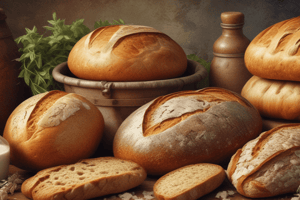Podcast
Questions and Answers
What are the typical grades of bread flours and their characteristics?
What are the typical grades of bread flours and their characteristics?
Top Grade, Baker’s Extra Grade, Bakers Grade, and Euro Baker’s Grade. Each has its own specific characteristics.
What characteristics differentiate Top Grade, Baker’s Extra Grade, Bakers Grade, and Euro Baker’s Grade?
What characteristics differentiate Top Grade, Baker’s Extra Grade, Bakers Grade, and Euro Baker’s Grade?
Each grade has unique characteristics that make it suitable for specific baking purposes.
Why is it important for bakers to be familiar with the characteristics of different bread flour grades?
Why is it important for bakers to be familiar with the characteristics of different bread flour grades?
Understanding the characteristics of different bread flour grades allows bakers to select the most suitable flour for specific recipes and achieve desired baking results.
Outline the typical grades of bread flours and their respective characteristics, focusing on ______ Grade, Baker’s Extra Grade, Bakers Grade, and Euro Baker’s Grade.
Outline the typical grades of bread flours and their respective characteristics, focusing on ______ Grade, Baker’s Extra Grade, Bakers Grade, and Euro Baker’s Grade.
What characteristics differentiate ______ Grade, Baker’s Extra Grade, Bakers Grade, and Euro Baker’s Grade?
What characteristics differentiate ______ Grade, Baker’s Extra Grade, Bakers Grade, and Euro Baker’s Grade?
Why is it important for bakers to be familiar with the characteristics of different bread flour ______?
Why is it important for bakers to be familiar with the characteristics of different bread flour ______?
Flour is normally supplied to meet a ______
Flour is normally supplied to meet a ______
A typical range of bread flours would look as follows: Top Grade, Baker’s Extra Grade, Baker’s Grade, Euro Baker’s Grade. Top Grade would have a substantial proportion of Canadian wheat and would be suitable for any long process. It can be used to make ordinary bread but is more likely to be used to make ______
A typical range of bread flours would look as follows: Top Grade, Baker’s Extra Grade, Baker’s Grade, Euro Baker’s Grade. Top Grade would have a substantial proportion of Canadian wheat and would be suitable for any long process. It can be used to make ordinary bread but is more likely to be used to make ______
The protein content of Top Grade bread flour could be as high as ______% with a water absorption of 62-64%
The protein content of Top Grade bread flour could be as high as ______% with a water absorption of 62-64%
Baker’s Extra Grade has less imported wheat and a lower protein content than the top grade but more than the baker’s grade. The protein content might be ______%
Baker’s Extra Grade has less imported wheat and a lower protein content than the top grade but more than the baker’s grade. The protein content might be ______%
Euro Baker’s Grade is a baker’s flour similar to the standard baker’s grade but without any non-EU wheat. As it would match the protein content of baker’s grade, dried vital wheat gluten would be used to make up the protein content. This product would only be suitable for quick processes like the ______ mixer
Euro Baker’s Grade is a baker’s flour similar to the standard baker’s grade but without any non-EU wheat. As it would match the protein content of baker’s grade, dried vital wheat gluten would be used to make up the protein content. This product would only be suitable for quick processes like the ______ mixer
Flashcards are hidden until you start studying




